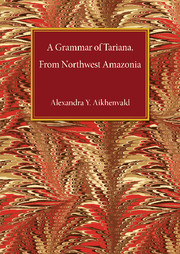Book contents
- Frontmatter
- Dedication
- Contents
- List of tables, schemes and diagrams
- Preface
- Acknowledgements
- Organisation and cross-referencing
- List of abbreviations
- Map
- 1 The language and its speakers
- 2 Phonology
- 3 Word classes
- 4 Nominal morphology and noun structure
- 5 Noun classes and classifiers
- 6 Possession
- 7 Case marking and grammatical relations
- 8 Number
- 9 Further nominal categories
- 10 Derivation and compounding
- 11 Closed word classes
- 12 Verb classes and predicate structure
- 13 Valency changing and argument rearranging mechanisms
- 14 Tense and evidentiality
- 15 Aspect, Aktionsart and degree
- 16 Mood and modality
- 17 Negation
- 18 Serial verb constructions and verb compounding
- 19 Complex predicates
- 20 Participles and nominalisations
- 21 Clause types and other syntactic issues
- 22 Subordinate clauses and clause linking
- 23 Relative clauses
- 24 Complement clauses
- 25 Discourse organisation
- 26 Issues in etymology and semantics
- Appendix. The main features of the Tariana dialects
- Texts
- Vocabulary
- References
- Index of authors, languages and subjects
1 - The language and its speakers
Published online by Cambridge University Press: 05 August 2013
- Frontmatter
- Dedication
- Contents
- List of tables, schemes and diagrams
- Preface
- Acknowledgements
- Organisation and cross-referencing
- List of abbreviations
- Map
- 1 The language and its speakers
- 2 Phonology
- 3 Word classes
- 4 Nominal morphology and noun structure
- 5 Noun classes and classifiers
- 6 Possession
- 7 Case marking and grammatical relations
- 8 Number
- 9 Further nominal categories
- 10 Derivation and compounding
- 11 Closed word classes
- 12 Verb classes and predicate structure
- 13 Valency changing and argument rearranging mechanisms
- 14 Tense and evidentiality
- 15 Aspect, Aktionsart and degree
- 16 Mood and modality
- 17 Negation
- 18 Serial verb constructions and verb compounding
- 19 Complex predicates
- 20 Participles and nominalisations
- 21 Clause types and other syntactic issues
- 22 Subordinate clauses and clause linking
- 23 Relative clauses
- 24 Complement clauses
- 25 Discourse organisation
- 26 Issues in etymology and semantics
- Appendix. The main features of the Tariana dialects
- Texts
- Vocabulary
- References
- Index of authors, languages and subjects
Summary
Linguistic profile of Tariana
Tariana is the only Arawak language spoken in the linguistic area of the Vaupés river basin in the territory of the Upper Rio Negro in northwestern Brazil. All the other languages belong to the East Tucano subgroup of the Tucano family. The main feature of the Vaupés area is its obligatory multilingualism, dictated by the principles of linguistic exogamy (one has to marry someone who speaks a different language). There is a strong inhibition against ‘language-mixing’, viewed in terms of lexical loans. As the result of a long-term interaction, Tariana combines a few features inherited from Proto-Arawak, with those diffused from East Tucano. Independent innovations in Tariana include grammatical phenomena divergent from those found in closely related languages and not explainable in terms of the influence of the East Tucano languages (see Aikhenvald 1999b, c).
Tariana is polysynthetic and basically head-marking (in the sense of Nichols 1986), with elements of dependent-marking – the latter due to the Tucano influence since most Arawak languages are entirely head-marking (see Aikhenvald 1999b).
Tariana has twenty-five consonants and six vowels. As in many other Arawak languages of the area, there is a series of aspirated stops, preaspirated nasals and a glide. The vowels a, i, e and u have long and nasal counterparts, while o has only a nasal counterpart, and ᵼ has neither. The emergence of ᵼ and o, the two vowels with a limited distribution, is most probably due to the Tucano influence.
- Type
- Chapter
- Information
- A Grammar of Tariana, from Northwest Amazonia , pp. 1 - 24Publisher: Cambridge University PressPrint publication year: 2003



